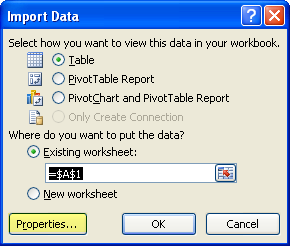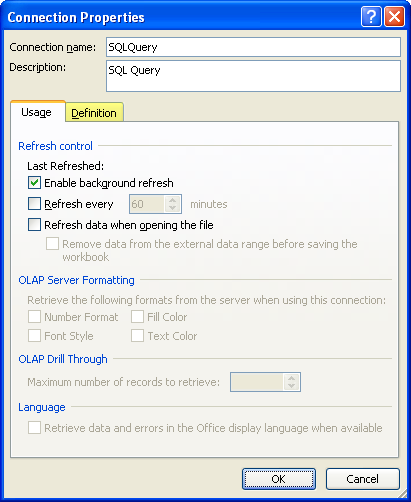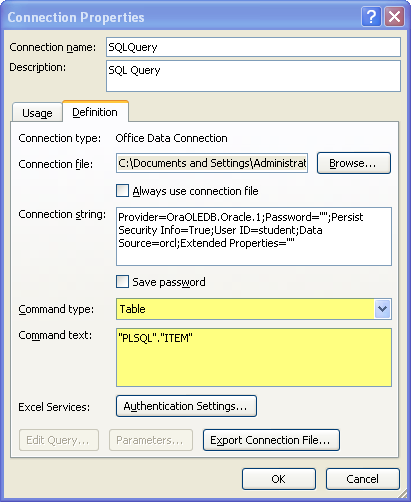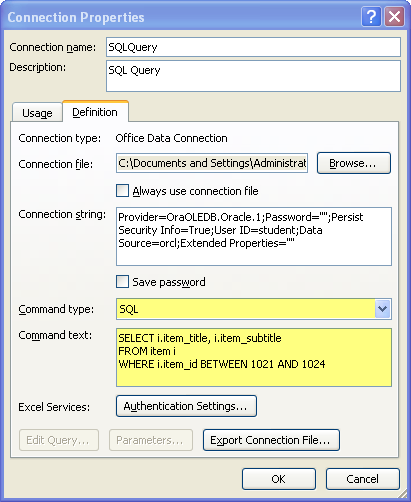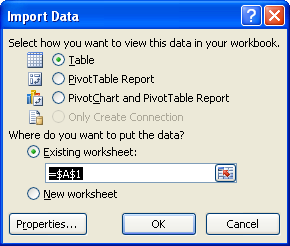Archive for the ‘Oracle’ Category
Haste makes waste, again …
I was working on a code example for my database class, got in a hurry, and changed a table name without dropping the original table. Oops!
Naturally, I got this error message.
LOB (administrator_photo) STORE AS admin_photo * ERROR at line 5: ORA-00955: name IS already used BY an existing object |
The LOB segment name existed but why and where. It was in the table that I forgot to drop. This query find the latent table and column while illustrating the relationship (for my students and others) between an OBJECT_NAME and SEGMENT_NAME:
SELECT TABLE_NAME, column_name FROM user_lobs WHERE segment_name = (SELECT object_name FROM user_objects WHERE object_name = UPPER('&object_name') AND object_type = 'LOB'); |
Now, I can grab it later because it’ll happen again. 😉 At Samy mentioned in his comment you also have the option of using ALL_ or DBA_ views when you’re a DBA.
The class, they survived …
The rumor is that my database is hard, but I’ve always hoped it was fun and laid the foundation of success for my students. As I walked into class to give them their final exam, they had their jackets on, which isn’t uncommon for Rexburg, Idaho in December. However, that’s normal outside but unusual in the heated classroom. Then, they all took their jackets off to show their new t-shirts.
They thought it would be fun to post on the blog, so here it is. The shirts says:
SELECT i.survived FROM michael_mclaughlin i WHERE class= CIT 320; |
It’s unfortunate that they missed the enclosing quote marks around the string literal. 😉 It should be like this:
SELECT i.survived FROM michael_mclaughlin i WHERE i.class= 'CIT 320'; |
Here’s to a great group of students who know how to read, write, and think SQL. Any openings out there for internships, please drop me a note.
Happy holidays!
Oracle 11g XDB Shake & Bake
It’s a bit awkward when a post generates a new question, but here’s a quick explanation and example of using XDB (XML Database Server) outside of the realm of APEX. More or less, XDB is an Apache Server equivalent configured inside the database. It’s really a protocol server tied into the Shared Server Oracle*Net Architecture (a correction provided by Marco Gralike). As a note, testing was done by using a NAT static IP addressing for the virtual Windows XP, Vista, and 7 environments.
This blog post will show you how to experiment with the PL/SQL Web Toolkit and build both password protected and unprotected database content. It assumes you have access to the SYS privileged account.
Setting Up a Secure DAD
There’s secure and then there’s secure. This falls in the less than secure category but it does provide a password and uses basic HTTP authentication. The USER is the schema name, and the PASSWORD is the same as that for the SQL*Plus access to the schema.
- Connect as the privileged
SYSuser and run the following script. It creates a genericSTUDENTuser and grants minimalist privileges, then it creates a DAD (Data Access Descriptor), and authorizes the DAD. Don’t run the command if you’re actively using Oracle APEX on the default configuration of port 8080. It’s there for those folks you are running Tomcat on 8080.
-- This resets the default port so that it doesn't conflict with other environment. EXECUTE dbms_xdb.SETHTTPPORT(8181); -- This creates the STUDENT Data Access Descriptor. EXECUTE dbms_epg.create_dad('STUDENT_DAD','/sampledb/*'); -- This authorizes the STUDENT_DAD EXECUTE dbms_epg.authorize_dad('STUDENT_DAD','STUDENT'); |
- Connect as the
STUDENTuser and run the following script to create a PL/SQL Web Toolkit procedure.
1 2 3 4 5 6 7 8 9 10 11 12 13 14 15 16 | CREATE OR REPLACE PROCEDURE HelloWorld AS BEGIN -- Set an HTML meta tag and render page. owa_util.mime_header('text/html'); -- <META Content-type:text/html> htp.htmlopen; -- <HTML> htp.headopen; -- <HEAD> htp.htitle('Hello World!'); -- <TITLE>HelloWorld!</TITLE> htp.headclose; -- </HEAD> htp.bodyopen; -- <BODY> htp.line; -- <HR> htp.print('Hello ['||USER||']!'); -- Hello [dynamic user_name]! htp.line; -- <HR> htp.bodyclose; -- </BODY> htp.htmlclose; -- </HTML> END HelloWorld; / |
- Open a browser of your choice, and enter the following URL.
http://localhost:8181/sampledb/helloworld |
You then see (or should see) the following Basic HTTP Authentication dialog box. Enter the STUDENT user as the User Name and the Password for the database account. Then, click the OK button.
Provided you enter the User Name and Password correctly, you should see the following inside the browser’s display panel. The USER name is a system session scope variable, which will always return the owner of the package because its created as a Definers Rights procedure.
You have now successfully configured your Basic HTTP Authentication XDB, which may offer you some possibilities outside of using Oracle APEX.
Setting Up an Unsecured DAD
The trick here is building on what you did by eliminating the authentication. You do this by using the ANONYMOUS account, like Oracle’s APEX does. Well, not quite like it does because APEX provides a very good user authentication model. It allows you to connect to the ANONYMOUS user where you present and validate your credentials.
Since you have to do all the prior steps, these steps are numbered after those above. You start with step #4.
- Generally, the XML configuration is missing one key node that allows repository anonymous access. The missing node disallows anonymous login. You can run the code below as the
SYSprivileged user to open that up if its missing. You can check whether or not it’s missing by running this as theSYSuser:
SQL> @?/rdbms/admin/epgstat.sql |
If it returns the following as the last element of the output, you’ll need to run the PL/SQL block below.
+-------------------------------------------------------------------+ | ANONYMOUS access to XDB repository: | | To allow public access to XDB repository without authentication, | | ANONYMOUS access to the repository must be allowed. | +-------------------------------------------------------------------+ Allow repository anonymous access? ---------------------------------- false 1 row selected. |
When you run this script, make sure you’re the privileged SYS user. Then, rerun the epgstat.sql script to verify that you’ve enabled anonymous access to the repository. You may also need to refresh your browser cache before retesting it.
1 2 3 4 5 6 7 8 9 10 11 12 13 14 15 16 17 18 19 20 21 22 23 24 25 26 27 28 29 30 31 32 33 34 35 36 37 38 39 40 | SET SERVEROUTPUT ON DECLARE lv_configxml XMLTYPE; lv_value VARCHAR2(5) := 'true'; -- (true/false) BEGIN lv_configxml := DBMS_XDB.cfg_get(); -- Check for the element. IF lv_configxml.existsNode('/xdbconfig/sysconfig/protocolconfig/httpconfig/allow-repository-anonymous-access') = 0 THEN -- Add missing element. SELECT insertChildXML ( lv_configxml , '/xdbconfig/sysconfig/protocolconfig/httpconfig' , 'allow-repository-anonymous-access' , XMLType('<allow-repository-anonymous-access xmlns="http://xmlns.oracle.com/xdb/xdbconfig.xsd">' || lv_value || '</allow-repository-anonymous-access>') , 'xmlns="http://xmlns.oracle.com/xdb/xdbconfig.xsd"') INTO lv_configxml FROM dual; DBMS_OUTPUT.put_line('Element inserted.'); ELSE -- Update existing element. SELECT updateXML ( DBMS_XDB.cfg_get() , '/xdbconfig/sysconfig/protocolconfig/httpconfig/allow-repository-anonymous-access/text()' , lv_value , 'xmlns="http://xmlns.oracle.com/xdb/xdbconfig.xsd"') INTO lv_configxml FROM dual; DBMS_OUTPUT.put_line('Element updated.'); END IF; -- Configure the element. DBMS_XDB.cfg_update(lv_configxml); DBMS_XDB.cfg_refresh; END; / |
- These tasks also require the privileged
SYSTEMuser account, and you should sign on to that account to run these commands. The first thing you may need to do is unlock theANONYMOUSaccount. It is locked by default. After you unlock it, you’ll need to verify no default password was assigned by unassigning a password. The following two commands accomplish those tasks.
-- Unlock the user account. ALTER USER anonymous ACCOUNT UNLOCK; -- Ensure a password is assigned to the account so you can create a synonym later. ALTER USER anonymous IDENTIFIED BY ANONYMOUS; |
- These tasks require the privileged
SYSuser account because you’re going to create and authorize another DAD.
-- This creates the STUDENT_DB_DAD Data Access Descriptor. EXECUTE dbms_epg.create_dad('STUDENT_DB_DAD','/db/*'); -- This authorizes the STUDENT_DB_DAD EXECUTE dbms_epg.authorize_dad('STUDENT_DB_DAD','ANONYMOUS'); -- Open the anonymous account by setting the database-username parameter and value. EXECUTE dbms_epg.set_dad_attribute('STUDENT_DB_DAD','database-username','ANONYMOUS'); |
- Connect as the
STUDENTuser and grantEXECUTEpermissions on theHELLOWORLDprocedure to theANONYMOUSuser account. TheGRANTallows you to give unrestricted access to theANONYMOUSaccount, which in turn provides it to your web audience.
SQL> GRANT EXECUTE ON helloworld TO anonymous; |
- Connect as the
ANONYMOUSuser and create a local synonym that point to theSTUDENT.HELLOWORLDprocedure. TheSYNONYMprovides a program name for the URL statement. It’s hides the ownership of the actual procedure by supressing the schema name. (You may need to grantCREATE ANY SYNONYMas theSYSTEMuser to theANONYMOUSuser.)
SQL> CREATE SYNONYM helloworld FOR student.helloworld; |
ANONYMOUS account. The following syntax lets you do that as the privileged SYSTEM user.
SQL> ALTER USER anonymous IDENTIFIED BY NULL; |
- Open a browser of your choice, and enter the following URL, which won’t require a User Name or Password.
http://localhost:8181/db/helloworld |
You should see the same browser panel information as that shown by step #3 above, except one thing. The difference is the user name, which should now be ANONYMOUS. The execution occurs with the permissions of the invoker. This means you’ll see the data you’re allowed to see by the owning schema.
Oracle 11g XDB DADs
Somebody asked me why the DBMS_EPG.GET_DAD_LIST is a procedure because you can’t just simply list the DAD values. I answered that Oracle chose to implement it that way. Then, they asked how they could query it. I suggested they just run the epgstat.sql diagnostic script provided in the $ORACLE_HOME/rdbms directory, which provides those values and much more.
You can run the diagnostic script as the SYS privileged user, or as any user that has been granted the XDBADMIN role, like this:
SQL> @?/rdbms/admin/epgstat.sql |
Notwithstanding the diagnostic script, they asked how you could wrap the OUT mode PL/SQL data type in the procedure call, and return the list of values in a SQL query. Because the formal parameter is a PL/SQL data type, this requires two key things. One is a local variable that maps to the DBMS_EPG package collection data type, and a pipelined table function. Here’s one way to solve the problem:
1 2 3 4 5 6 7 8 9 10 11 12 13 14 15 16 17 18 19 20 21 22 23 24 25 26 27 28 29 30 | CREATE OR REPLACE TYPE dad_list AS TABLE OF VARCHAR2(4000); / CREATE OR REPLACE FUNCTION get_dbms_epg_dads RETURN dad_list PIPELINED IS -- Deine a local variable as the OUT mode target of GET_DAD_LIST procedure. SOURCE DBMS_EPG.VARCHAR2_TABLE; -- Declare a local variable of the SQL collection data type. list DAD_LIST := dad_list(); BEGIN -- Call the procedure to populate the source. dbms_epg.get_dad_list(SOURCE); -- Extend space for all defined DAD values. list.EXTEND(SOURCE.COUNT); -- Assign values from PL/SQL collection to SQL collection. FOR i IN 1..source.COUNT LOOP list(i) := SOURCE(i); PIPE ROW(list(i)); END LOOP; RETURN; END get_dbms_epg_dads; / -- Set SQL*Plus width. SET LINESIZE 79 -- Query collection. SELECT column_value AS "DAD LIST" FROM TABLE(get_dbms_epg_dads); |
Marco Gralike provided a simpler approach them the Pipelined Table Function here. I’ve copied the code example below:
1 2 3 4 5 6 | SELECT u.dad AS "PL/SQL DAD List" FROM XMLTable(XMLNAMESPACES ( DEFAULT 'http://xmlns.oracle.com/xdb/xdbconfig.xsd' ) , '/xdbconfig/sysconfig/protocolconfig/httpconfig/webappconfig/servletconfig/servlet-list/servlet[servlet-language="PL/SQL"]' PASSING DBMS_XDB.CFG_GET() COLUMNS DAD VARCHAR2(15) PATH '/servlet/servlet-name/text()') u; |
Hope this proves handy to somebody else, too.
SQL Query in Excel 2007
Over a year ago, I put out a blog page on how to query the contents of a table from an Oracle database through Excel. I meant to get back to provide much more about this. Specifically, I want to cover the XML mechanism used to accomplish the task. However, a blog reader augmented my page with a solution comment. I’m thrilled he did because it tells me to get a basic thing out rather than hang folks up halfway. My thanks go to Vernon.
Here’s a quick addendum to the original post with screen shots because folks tell me they’re very useful. It demonstrates how you write queries in Microsoft Excel against the Oracle database. While I plan a full tutorial on a different URL, this should help everybody in the meantime. This content is dependent on the generic mechanism, which I covered in this older post.
It starts with an alternative to Step #9 in the older blog page, and therefore, I’ve started the numbering as 9 there.
- The Import Data dialog asks you how and where you want to import it. When you don’t want the contents of a simple table, click the Properties button.
- Clicking the prior dialog’s Property button brings you to the Connection Properties dialog. The Usage tab is first for a reason but the Definition tab is where you need to go to enter a free form query. Click the Definition tab highlighted in yellow below.
- In this dialog, the most important boxes are the Command type (as you may guess, Table is the default value) and Command text boxes. The first thing to do, is click on the Command type multiple select widget and choose SQL.
Now, you can write any query that you’d like against the selected Oracle schema. You may reference any tables or views for which your user (schema) has SELECT permissions. You don’t need to limit yourself to a single table because ANSI SQL:89 (comma delimited tables), and ANSI SQL:92 (INNER JOIN, et cetera) are both supported. Don’t forget that Oracle uses a different concatenation method than Microsoft Access or SQL Server, you can find that here. After you’ve entered your query, click the OK button to proceed.
- When you clicked OK, you’ve instructed Microsoft Excel 2007 to change the connection, it raises this dialog box (click on it if you want to read it). You click Yes to continue and save your query.
- You’re back to where you began, more or less, this it the Import Data dialog. This is Step #9 but this time it’ll run your query not return a simple table content. Click OK to run the query. Don’t be surprised if you get a message saying no password was provided. It just means you’ll be prompted to enter one. You should never store that password because it’s stored in plain text inside an XML file.
You can find those data source files in this directory:
C:\Document and Settings\<some_user>\My Documents\My Data Sources |
Windows 7 and Zend CE
Installed Zend Community Edition on Windows 7 64-bit. It worked easily. You just need to remember to install the JSDK 32-bit version for the Java Bridge. Clear notation about phpMyAdmin and MySQL being separate downloads has been added to the new Zend Community Edition Server (4.0.6), and it clearly does support Windows 7.
If you plan on installing MySQL and Oracle, I would recommend you install MySQL after you install Oracle and the Zend Community Server. However, it doesn’t matter because both ways work.
That completes my WAMP (Windows, Apache, MySQL, Perl, PHP, or Python) and OPAW (Oracle, Perl, PHP, or Python, Apache, Windows) installations. Actually, I’m not sure there is an OPAW acronym for a LAMP stack running Oracle on a Windows platform. OPAL is the acronym for a LAMP stack running an Oracle database, but I’ve never seen one before for Windows. Therefore, I created one.
My two cents worth …
I’d vote for clearer guidance on these acronyms. After all, they’re only purpose appears to be how to market variants of LAMP. The variants that I’ve seen for LAMP (Linux) are: MAMP (Mac OS X), SCAMP (Santa Cruz Operation), SAMP (Solaris), OAMP (OpenBSD, and WAMP (Windows) for MySQL database versions. The key seems to be swapping the first letter. I’ve only seen OPAL (Linux) officially for a LAMP stack that uses an Oracle database on a Linux platform. While my OPAW leverages what I perceive as a possible pattern, it may be wrong. Does anybody know what the right way to label these is?
Oracle 11g on Windows 7
I finally got around to installing Oracle 11g on Windows 7 Professional Edition, 64-bit (click here for Oracle 11g Release 2 on Windows 7). The only catch was that the Oracle 11g (11.1.0.7) installer validates only against Windows 5.0, 5.1, 5.2 or 6.0. Windows 7 is actually Windows Code Base 6.1, as seen in this screen shot after successful installation:
With that knowledge, first you should download the software from Oracle’s web site. You should unzip the contents into another directory. I used a C:\Stage directory. Inside that you’ll find the database directory, and it should look like this:
- Click on the
setupicon to launch the installer. You should then see the following screen shot. Enter a password for theSYSandSYSTEMusers (if you’re coming to Oracle from a MySQL background they’re like therootuser in MySQL). When you’ve entered a matching password in both fields, the Install button becomes active. Click the Install button to proceed.
- In this screen, you’re prompted for your Email and MetaLink Password. If this is a test database (a throw away instance without any real data), you can uncheck the box for automatic security updates. You should enter a password even for test databases. Click the Next button to proceed.
- You’ll only see this failure if you’re installing Oracle 11g (11.1.0.7) on a Windows 7 operating system, which is actually version 6.1 according to their code control numbering. You simply check the Checking operating system requirements … and Checking service pack requirements … to override the prerequisite checks. Another error that you may encounter is related to networking. It is a warning and occurs when you’re operating system uses DHCP to get its IP address. You really should configure the operating system with a static IP address. You can set a static IP address in Windows 7 with these instructions.
- At this point, you’ll get a Windows System Alert asking you to unblock the installer’s
javaw.exeprogram. You must grant the access or forget about installing Oracle 11g. Click the Allow access button to proceed.
- The dialog tells you what will be installed. Click the Install button to proceed.
- This is the installation progress dialog. It’s running while the Oracle Installer lays down the operating system files for the database management system. It takes about 8 to 9 minutes, so stretch your legs if you want to take a break. When it’s 100% complete, click the Next button to continue.
- After the installation, you’ll see the first of the Configuration Assistants, which is the Oracle Net Configuration Assistant (unfortunately, I didn’t capture that screen shot but I provided a temporary substitute until I re-install it). Provided everything happens successfully, it’ll move to the next step without your intervention.
java.exe proceed with the installation.
- This one is exactly where it belongs. It means you have approximately a 5 to 6 minute break while a sample database instance is cloned for you. The cloning process copies a sample compressed database from the installation staging area to your local operating system.
- The last Configuration Assistant is the Oracle Configuration Manager Configuration. It’s a short process, it configures the cloned sample database against your installation names and passwords. When it completes it enables the Next button. Click the Next button to complete the installation.
- You’ve finally reached almost the end of the installation. Click the Exit button on this dialog to proceed to the “are you sure” dialog box.
You’ve successfully installed Oracle 11g on Windows 7.
No Java in Oracle XE
While helping in the forum, I noticed that folks don’t know that Java isn’t deployed with the Oracle 10g XE. However, it strikes me that you might be able to fudge it but I’m not sure that’s allowed in the EULA. If you want Java inside the database, why wouldn’t you install the licensed product?
There was an OTN article that listed three limitations but this wasn’t one in the article. Maybe I’ll run across the marketing note sometime in the furture or somebody will post the URL as a comment, which is always appreciated.
Anyway, the presence or lack of Java inside the database is pretty easy to test. You only need to do this:
SQL*Plus: Release 10.2.0.1.0 - Production ON Thu Nov 26 21:19:42 2009 Copyright (c) 1982, 2005, Oracle. ALL rights reserved. Connected TO: Oracle DATABASE 10g Express Edition Release 10.2.0.1.0 - Production SQL> CREATE OR REPLACE AND RESOLVE JAVA SOURCE NAMED HelloWorldSQL AS 2 public class HelloWorldSQL { 3 public static String hello() { 4 RETURN "Hello World."; } 5 } 6 / CREATE OR REPLACE AND RESOLVE JAVA SOURCE NAMED HelloWorldSQL AS * ERROR at line 1: ORA-29538: Java NOT installed |
This is also true for Oracle Database 11g XE, as shown:
SQL*Plus: Release 11.2.0.2.0 Production ON Fri DEC 9 02:34:20 2011 Copyright (c) 1982, 2011, Oracle. ALL rights reserved. Connected TO: Oracle DATABASE 11g Express Edition Release 11.2.0.2.0 - 64bit Production SQL> CREATE OR REPLACE AND RESOLVE JAVA SOURCE NAMED HelloWorldSQL AS 2 public class HelloWorldSQL { 3 public static String hello() { 4 RETURN "Hello World!"; } 5 } 6 / CREATE OR REPLACE AND RESOLVE JAVA SOURCE NAMED HelloWorldSQL AS * ERROR at line 1: ORA-29538: Java NOT installed |
It also explains the lack of loadjava or dropjava from the $ORACLE_HOME/bin directory.
Seeding a Calendar Table
While working on one of the labs, my students wanted a quick way to seed their CALENDAR table. Here’s a small script to seed twenty years of a calendar.
-- Conditionally drop the table. BEGIN FOR i IN (SELECT TABLE_NAME FROM user_tables WHERE TABLE_NAME = 'MOCK_CALENDAR') LOOP EXECUTE IMMEDIATE 'DROP TABLE '||i.table_name||' CASCADE CONSTRAINTS'; END LOOP; END; / -- Create the table. CREATE TABLE mock_calendar ( short_month VARCHAR2(3) , long_month VARCHAR2(9) , start_date DATE , end_date DATE ); -- Seed the table with 10 years of data. DECLARE -- Create local collection data types. TYPE smonth IS TABLE OF VARCHAR2(3); TYPE lmonth IS TABLE OF VARCHAR2(9); -- Declare month arrays. short_month SMONTH := smonth('JAN','FEB','MAR','APR','MAY','JUN' ,'JUL','AUG','SEP','OCT','NOV','DEC'); long_month LMONTH := lmonth('January','February','March','April','May','June' ,'July','August','September','October','November','December'); -- Declare base dates. start_date DATE := '01-JAN-79'; end_date DATE := '31-JAN-79'; -- Declare years. years NUMBER := 20; BEGIN -- Loop through years and months. FOR i IN 1..years LOOP FOR j IN 1..short_month.COUNT LOOP INSERT INTO mock_calendar VALUES ( short_month(j) , long_month(j) , add_months(start_date,(j-1)+(12*(i-1))) , add_months(end_date,(j-1)+(12*(i-1)))); END LOOP; END LOOP; END; / -- Format set break for output. SET PAGESIZE 16 -- Format column output. COL short_month FORMAT A5 HEADING "Short|Month" COL long_month FORMAT A9 HEADING "Long|Month" COL start_date FORMAT A9 HEADING "Start|Date" COL end_date FORMAT A9 HEADING "End|Date" SELECT * FROM mock_calendar; |
The output will look like this with a page break by year:
Short Long Start End Month Month Date Date ----- --------- --------- --------- JAN January 01-JAN-79 31-JAN-79 FEB February 01-FEB-79 28-FEB-79 MAR March 01-MAR-79 31-MAR-79 APR April 01-APR-79 30-APR-79 MAY May 01-MAY-79 31-MAY-79 JUN June 01-JUN-79 30-JUN-79 JUL July 01-JUL-79 31-JUL-79 AUG August 01-AUG-79 31-AUG-79 SEP September 01-SEP-79 30-SEP-79 OCT October 01-OCT-79 31-OCT-79 NOV November 01-NOV-79 30-NOV-79 DEC December 01-DEC-79 31-DEC-79 |
Oracle Ace Award
I’d tweeted about the award last night but apparently the Oracle ACE Directory Server is down at the moment. At least, I got an AIM message to that effect. Fortunately, I’d left the browser open on my machine on that page. So, here’s the image you’d see on the server when it’s back up.
It’s nice to have received the award.


